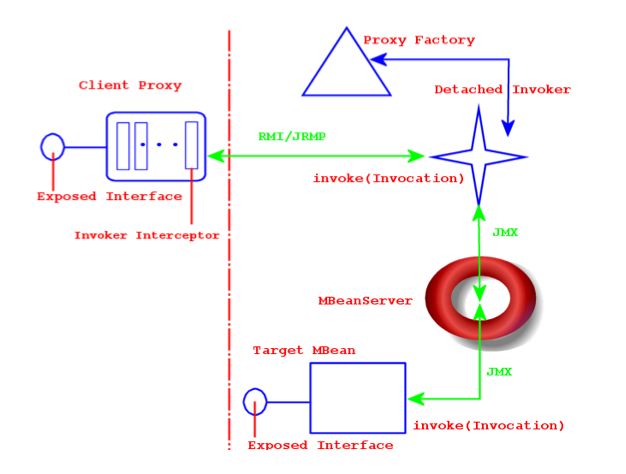In addition to the MBean services notion that allows for the ability to integrate arbitrary functionality, JBoss also has a detached invoker concept that allows MBean services to expose functional interfaces via arbitrary protocols for remote access by clients. The notion of a detached invoker is that remoting and the protocol by which a service is accessed is a functional aspect or service independent of the component. Thus, one can make a naming service available for use via RMI/JRMP, RMI/HTTP, RMI/SOAP, or any arbitrary custom transport.
Let's begin our discussion of the detached invoker architecture with an overview of the components involved. The main components in the detached invoker architecture are shown in Figure 3.21, “The main components in the detached invoker architecture”.
On the client side, there exists a client proxy which exposes the interface(s) of the MBean service. This is the same smart, compile-less dynamic proxy that we use for EJB home and remote interfaces. The only difference between the proxy for an arbitrary service and the EJB is the set of interfaces exposed as well as the client side interceptors found inside the proxy. The client interceptors are represented by the rectangles found inside of the client proxy. An interceptor is an assembly line type of pattern that allows for transformation of a method invocation and/or return values. A client obtains a proxy through some lookup mechanism, typically JNDI. Although RMI is indicated in Figure 3.21, “The main components in the detached invoker architecture”, the only real requirement on the exposed interface and its types is that they are serializable between the client server over JNDI as well as the transport layer.
The choice of the transport layer is determined by the last interceptor in the client proxy, which is referred to as the Invoker Interceptor in Figure 3.21, “The main components in the detached invoker architecture”. The invoker interceptor contains a reference to the transport specific stub of the server side Detached Invoker MBean service. The invoker interceptor also handles the optimization of calls that occur within the same VM as the target MBean. When the invoker interceptor detects that this is the case the call is passed to a call-by-reference invoker that simply passes the invocation along to the target MBean.
The detached invoker service is responsible for making a generic invoke operation available via the transport the detached invoker handles. The Invoker interface illustrates the generic invoke operation.
package org.jboss.invocation;
import java.rmi.Remote;
import org.jboss.proxy.Interceptor;
import org.jboss.util.id.GUID;
public interface Invoker
extends Remote
{
GUID ID = new GUID();
String getServerHostName() throws Exception;
Object invoke(Invocation invocation) throws Exception;
}
The Invoker interface extends Remote to be compatible with RMI, but this does not mean that an invoker must expose an RMI service stub. The detached invoker service simply acts as a transport gateway that accepts invocations represented as the org.jboss.invocation.Invocation object over its specific transport, unmarshalls the invocation, forwards the invocation onto the destination MBean service, represented by the
Target MBean
in Figure 3.21, “The main components in the detached invoker architecture”, and marshalls the return value or exception resulting from the forwarded call back to the client.
The Invocation object is just a representation of a method invocation context. This includes the target MBean name, the method, the method arguments, a context of information associated with the proxy by the proxy factory, and an arbitrary map of data associated with the invocation by the client proxy interceptors.
The configuration of the client proxy is done by the server side proxy factory MBean service, indicated by the Proxy Factory component in Figure 3.21, “The main components in the detached invoker architecture”. The proxy factory performs the following tasks:
-
Create a dynamic proxy that implements the interface the target MBean wishes to expose.
-
Associate the client proxy interceptors with the dynamic proxy handler.
-
Associate the invocation context with the dynamic proxy. This includes the target MBean, detached invoker stub and the proxy JNDI name.
-
Make the proxy available to clients by binding the proxy into JNDI.
The last component in Figure 3.21, “The main components in the detached invoker architecture” is the Target MBean service that wishes to expose an interface for invocations to remote clients. The steps required for an MBean service to be accessible through a given interface are:
-
Define a JMX operation matching the signature:
public Object invoke(org.jboss.invocation.Invocation) throws Exception -
Create a
HashMap<Long, Method>mapping from the exposed interfacejava.lang.reflect.Methods to the long hash representation using theorg.jboss.invocation.MarshalledInvocation.calculateHashmethod. -
Implement the
invoke(Invocation)JMX operation and use the interface method hash mapping to transform from the long hash representation of the invoked method to thejava.lang.reflect.Methodof the exposed interface. Reflection is used to perform the actual invocation on the object associated with the MBean service that actually implements the exposed interface.
